Unlock the potential of your website with dynamic personalization. Explore tools, examples, and strategies for creating a tailored user experience.
March 15, 2024
Website Personalization Examples: Crafting Engaging Content
Question
Can you show what advanced on-site personalization actually looks like?
Answer
A personalized website seems to read your mind, presenting choices that perfectly aligned with your tastes and needs. This is the power of website personalization, which uses a variety of tools to create a unique experience for each site visitor. By leveraging personal data and behavior, websites can display content and offers that echo your individual interests, leading to a more engaging and satisfying browsing experience. Website personalization can increase engagement, enhance customer satisfaction, and elevate brand loyalty, making it an essential element for an effective digital marketing strategy.
In this article, we’ll explore the ins and outs of site personalization — from advantages and challenges to the 5 most effective tools you can use to create an effective website personalization strategy for your business. Plus, through a selection of successful examples of personalized websites, you’ll see how this concept is put into practice by businesses from various industries.
Content:
Understanding Website Personalization
At its core, web personalization involves using data and insights to customize the content, offers, and interactions a user encounters on a website. This could mean displaying different homepage banners based on the visitor’s location, suggesting products similar to what they’ve browsed in the past, or even greeting returning users by name. The goal is to make the browsing experience feel customized and personal, as though the website is engaging with each visitor directly, rather than broadcasting a generic user experience.
This approach relies heavily on data analytics and AI technologies to gather and interpret user data in real-time. From the pages they spend the most time on, to the products they add to their cart, each action a visitor takes is a piece of the puzzle. By analyzing this data, websites can identify patterns, preferences, and interests, enabling them to tailor their content more effectively.
Let’s examine an example of effective website personalization in action from United Colors of Benetton.
From the outset, the brand’s homepage greets visitors with a message confirming that the product range and delivery conditions are specifically relevant to their region (which is determined automatically or can be manually adjusted):
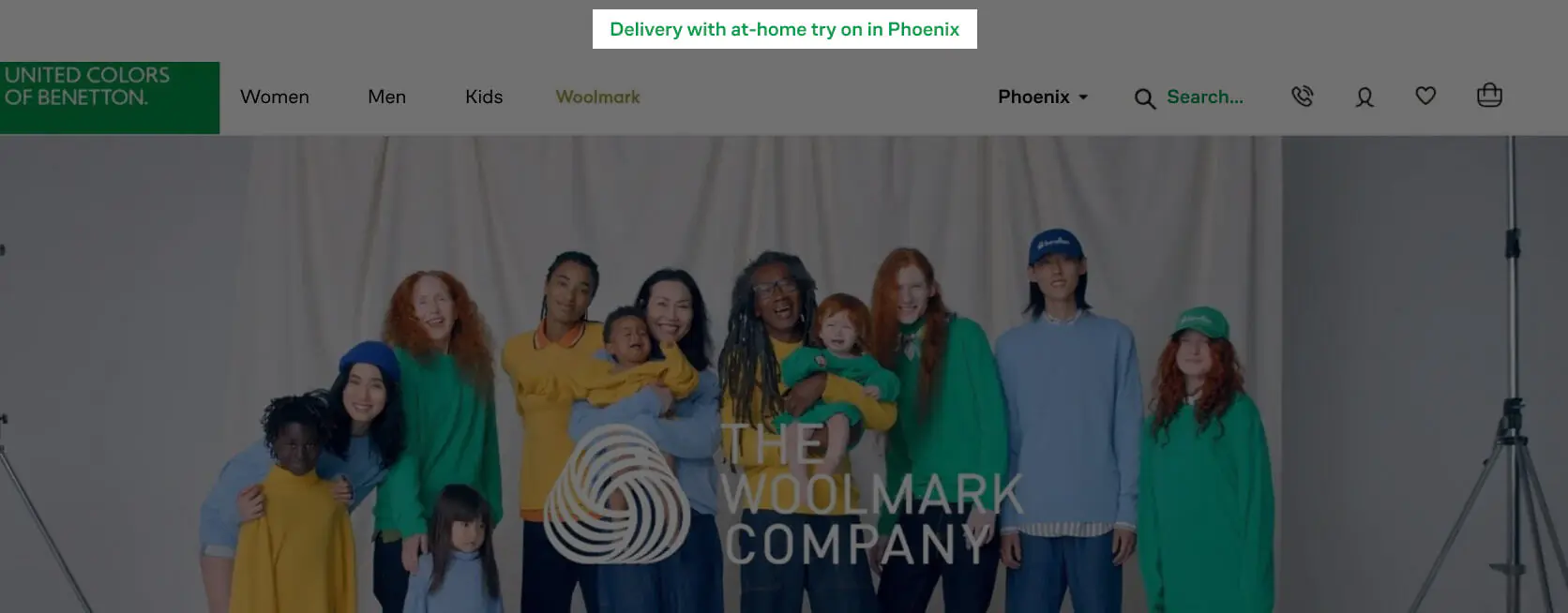
Customized message based on the visitor’s location
As shoppers navigate to individual product pages, they encounter up-to-date details on size availability within their chosen city:
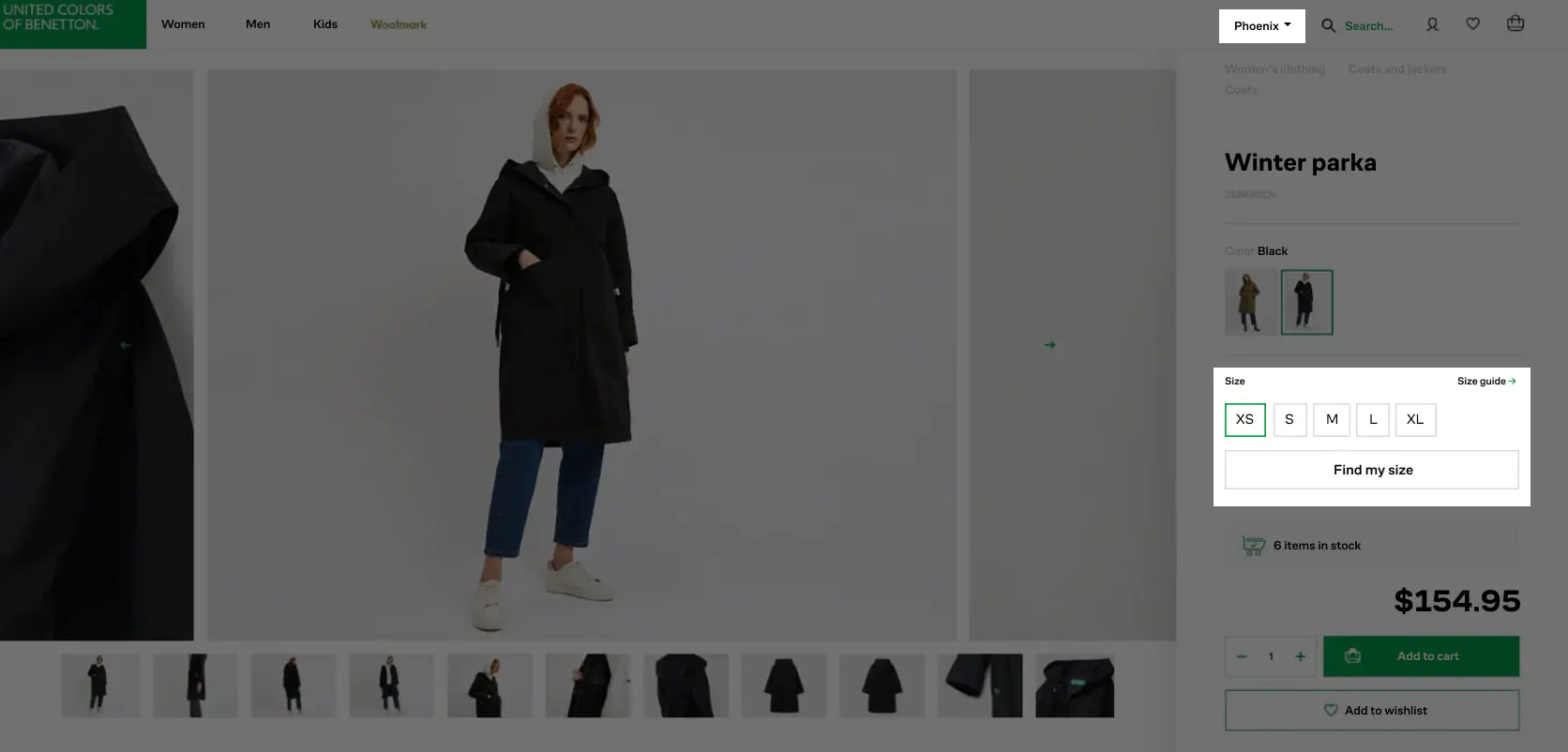
Personalized product card on one of United Colors of Benetton’s websites
Through these subtle touches, Benetton ensures that the shopping experience is not only convenient but also remarkably intuitive, leaving customers with the impression that everything on the website is personalized just for them.
Advantages of Website Personalization
Website personalization offers a multitude of benefits that can transform a basic online presence into a dynamic user experience, fostering stronger customer relationships and driving business growth. Here’s an overview of the key advantages:
Enhanced User Experience and Engagement
Personalization tailors a user’s web experience to their individual needs and preferences, creating a smoother and more engaging interaction. This can lead to increased time spent on the site, higher levels of user satisfaction, and a greater likelihood of return visits.
Whether it’s through targeted offers, personalized recommendations, or interactive elements, users are more likely to engage with relevant content that resonates with them on a personal level.
Increased Conversion Rates
Personalized calls-to-action (CTAs) and tailored content have been shown to boost conversion rates anywhere up to 202%. When users feel that the offers are customized just for them, they’re more inclined to take the desired action, be it making a purchase, signing up for a newsletter, or downloading a resource. As a basic example, you may want to display different buttons for first-time visitors and returning customers or use the customer’s name in the CTA if they are logged in.
Higher Customer Retention
Personalization helps build customer loyalty by making users feel valued and understood. When a site remembers a user’s preferences and past behaviors, it can create a loyal customer base that returns frequently because they receive a consistently relevant and convenient experience.
Website Personalization Challenges
Personalization can be a potent tool in a marketer’s arsenal, but it must be wielded with care. Here are some common challenges and ways to mitigate them:
Maintaining Privacy and Trust
Challenge: Users are increasingly concerned about their online privacy, and mishandling personal data can quickly erode trust.
Mitigation: Transparency is key — clearly communicate how data is collected, used, and protected. Offer users control over their data with clear options to opt-out of data collection or delete their information. Employing robust security measures to safeguard data is also crucial, such as two-factor authentication for staff with access to customer data.
Data Accuracy
Challenge: Incorrect or outdated data can lead to personalization mishaps, resulting in a poor user experience.
Mitigation: Implementing regular data audits and cleansing routines can maintain the integrity of the data. Encouraging users to update their preferences and using real-time data analysis can also improve accuracy. Consider employing machine learning algorithms that automatically adapt to changes in user behavior.
Overcoming Implementation Complexity
Challenge: The technical requirements for implementing personalization can be daunting, particularly for smaller businesses without extensive IT resources.
Mitigation: Smaller companies can start personalization based on a few key customer segments and simple behavior tracking — you can do this manually or use a platform like Maestra that can be adapted for businesses of all sizes. As you grow, invest in scalable personalization platforms (such as Maestra) that handle the complex data processing behind the scenes.
Top Five Website Personalization Tools + Examples
Diving deeper into the realm of site enhancement and personalization, let’s explore key tools and mechanisms that can significantly boost user engagement and sales.
1. Pop-ups and Embedded Content Blocks
Pop-ups "pop up" over the webpage to grab the visitor’s attention, whereas embedded content blocks are integral, more “permanent” parts of the page itself. Both serve similar purposes and are instrumental in increasing conversion rates (with the highest performing pop-ups demonstrating conversion rates of 42% or more), average order values, understanding the audience, and building a subscriber base. Here’s how they can be effectively deployed:
Lead Conversion
Pop-ups and embedded blocks of this type are designed to collect contact information, converting anonymous browsers into potential customers. A good example of a personalized lead collection pop-up comes from jewelry brand German Kabirski’s website. The brand’s website displays a personalized pop-up for new customers, offering to send them an email with a list of the products they browsed for a more convenient shopping experience:
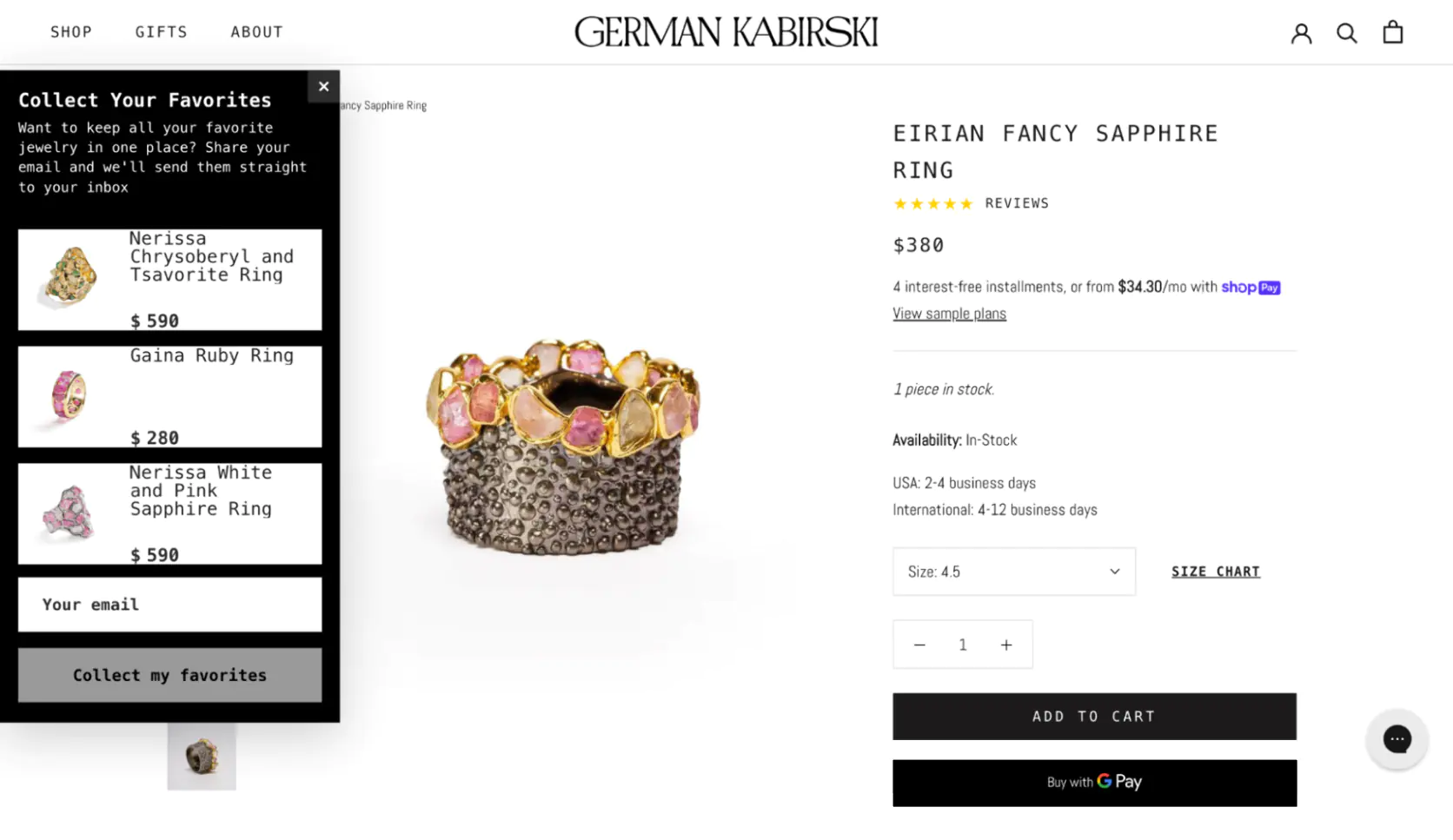
Lead collection pop-up featuring products the customer browsed during their session
After subscribing to the mailing list, the customer receives an email with their entire browsing history, making it more convenient for them to revisit these items at any moment.
Boosting Cart Conversion Rates
Pop-ups and embedded blocks can be used to incentivize customers to complete their purchase. For instance, Maestra’s client, Blossom Flower Delivery, used a floating bar pop-up on their website to motivate customers to complete orders and secure same-day delivery. To evaluate the effectiveness of this website personalization element, the team ran an A/A/B test in Google Optimize and compared two variants that did not have the floating bar with a third one that did. The test showed an 11% median uplift for the floating bar variant.
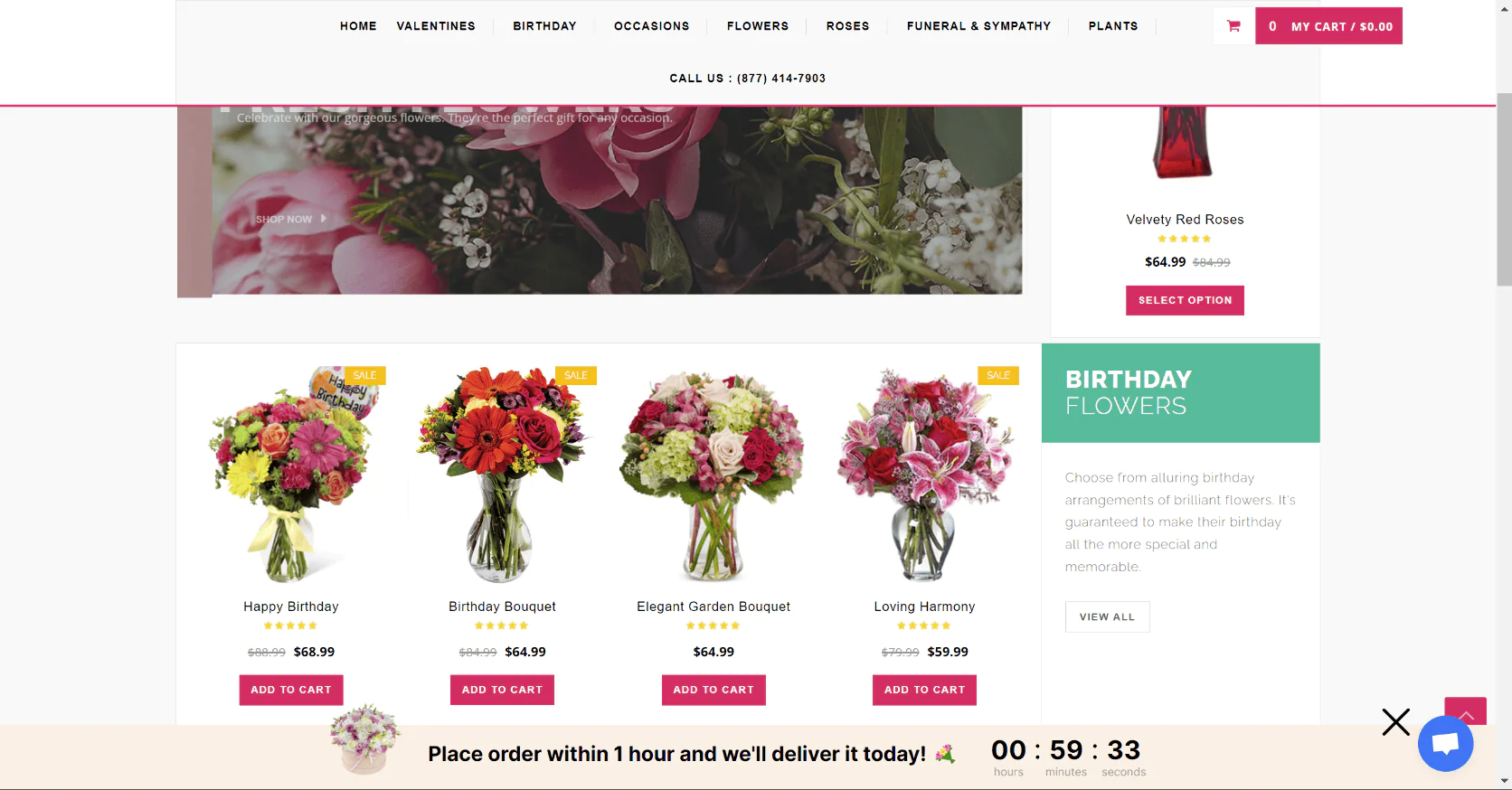
Blossom Flower’s “Place order within 1 hour and we’ll deliver today” floating bar pop-up
Increasing the Average Order Value (AOV)
Embedded content blocks or pop-ups with offers can be used to inform customers how close they are to earning free shipping, encouraging additional purchases without directly discounting products. This method subtly increases average order values while preserving margins.
The success of this approach lies in its ability to tap into the customer’s desire for maximized value. When customers are made aware that adding just a little more to their cart can earn them free shipping, it triggers a sense of achieving an extra benefit for what is perceived as a small additional cost. This perception of getting more value for their money is a strong motivator that can lead to increased spending.
For example, this block informs customers how much more they need to add to their cart to qualify for free shipping:

Embedded block aimed at increasing the average order value
Notifying Customers About Current Promotions
An embedded block can inform visitors about specific promotions or sales available to them. For instance, German Kabirski uses a personalized a floating bar pop-up for customers that landed on the website after following a link from an email campaign:
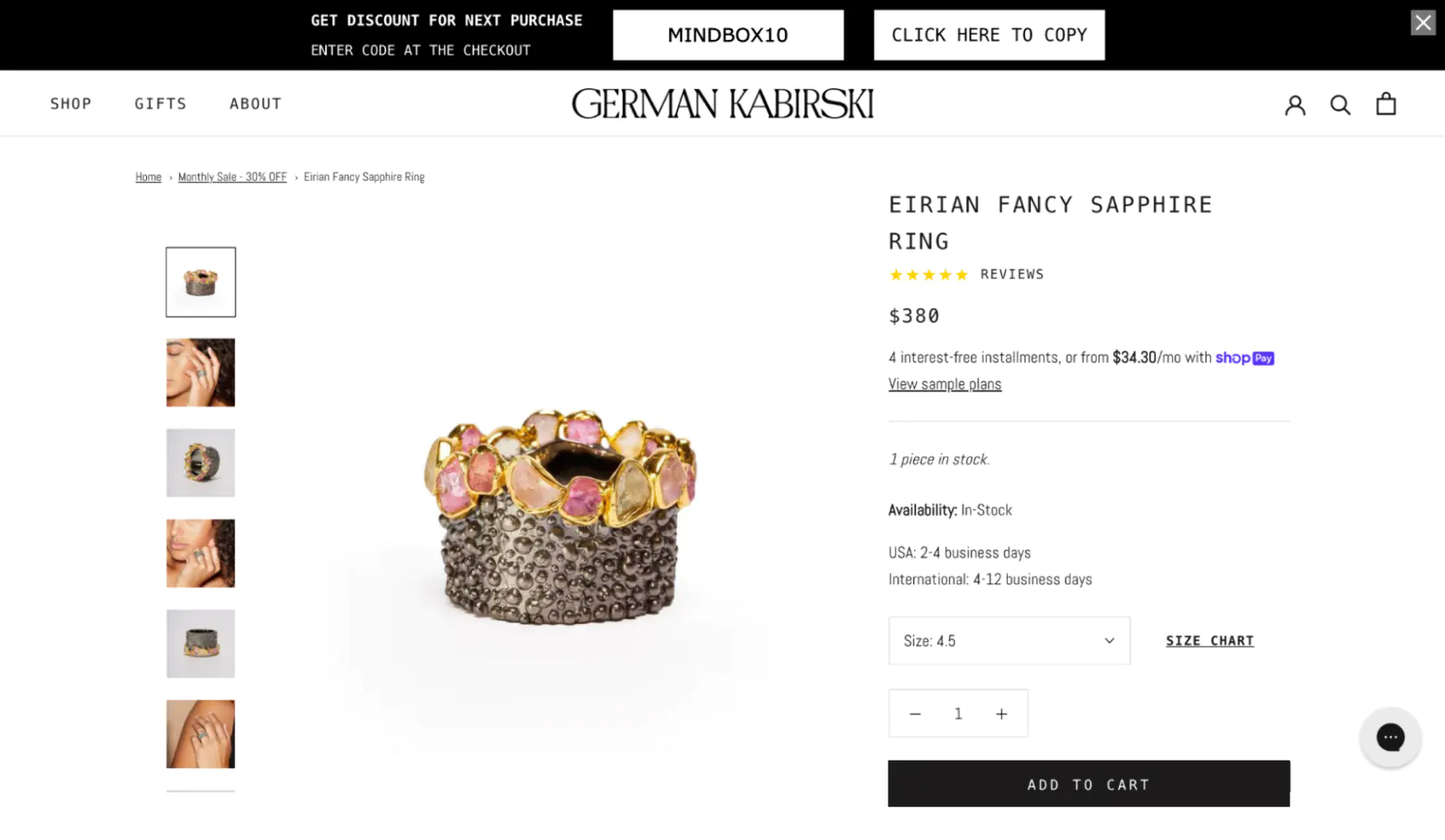
This floating bar contains the customer’s personalized discount code for easy access
Blossom Flower uses a similar approach, except that instead of a pop-up, they utilize an embedded sticky bar:
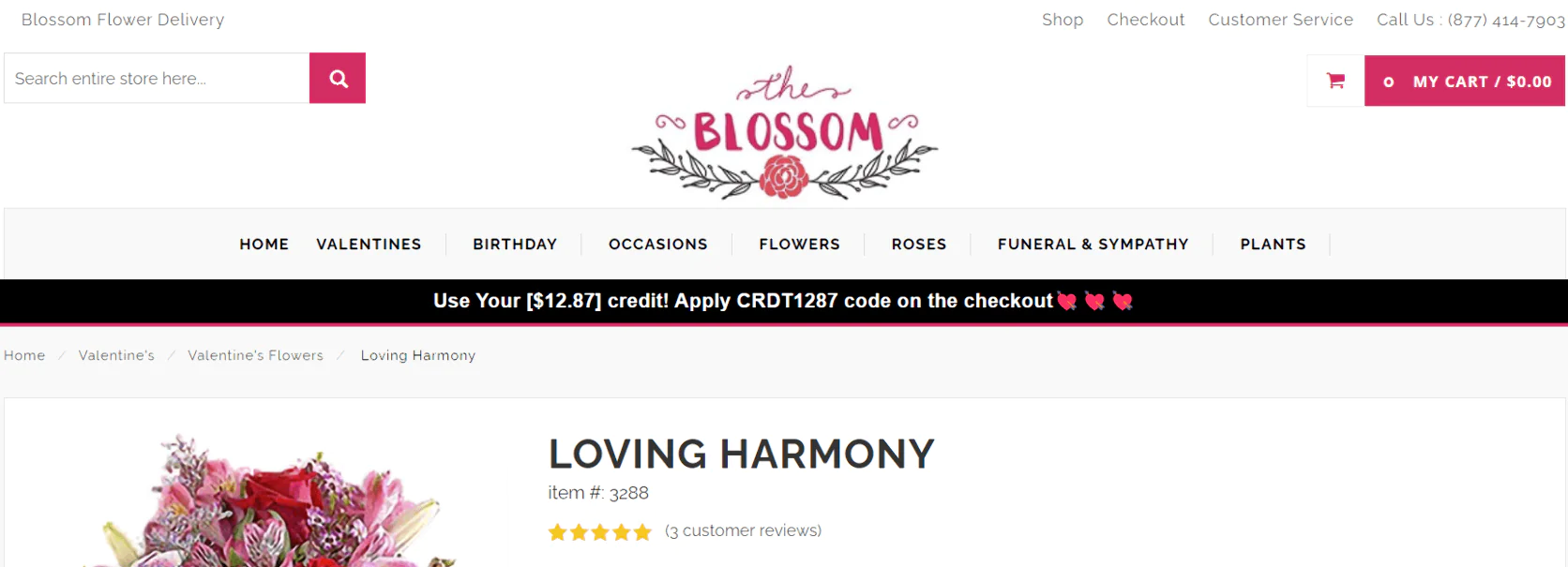
If a customer has landed on the website after following a link in an email with a promo code, the website displays a sticky bar with this code for easier access
Deeper Audience Insights
Surveys conducted through pop-ups can offer deep insights into customer needs and pain points. For example, Birkenstock’s online shoe store uses pop-ups for to launch surveys for different customer segments on its website, gathering valuable feedback. Based on survey results, Birkenstock tailors future bulk email campaigns, sending them to specific segments depending on the survey responses:
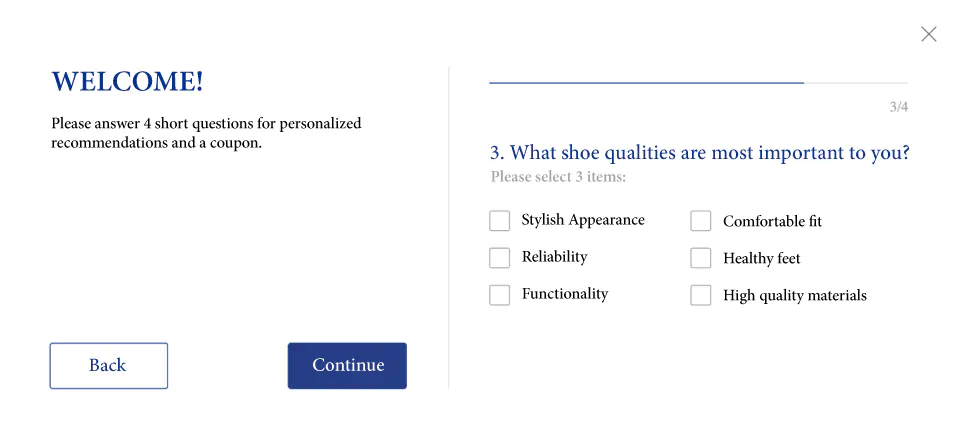
A pop-up survey for new customers on Birkenstock’s website
2. Product Recommendations
Product recommendations serve as an automated selection of goods likely to interest the website visitor. These can include popular products featured on the homepage to introduce visitors to the store’s key items, as well as suggesting items that complement what’s already in the shopper’s cart.
Popular Products
Highlighting popular products or "best sellers" is an effective way to showcase your store’s top offerings. This not only serves to introduce shoppers to the range of products available but also leverages the power of social proof, letting potential customers know that these items are trusted and favored by a wide audience.
Similar Products
Websites can automatically suggest similar products on product pages, taking into account factors like size, price, and brand specified in the recommendation settings. This approach helps to enhance the shopping experience by offering alternatives that closely match the visitor’s interests, increasing the likelihood of discovering products that meet their needs and preferences.
Complementary Products
Through a "product-to-product" recommendation approach brands can suggest complementary items — such as suggesting shoes to go with dresses or gloves to complement coats. These recommendations are based on the frequency with which items appear together in purchases and the correlation between product categories. This predictive capability is invaluable, even for new products that haven’t been purchased yet, by anticipating recommendations that align with established buying patterns.
Personalized Picks
All the aforementioned types of product recommendations can be tailored to meet the specific needs and expectations of individual site visitors. Machine learning algorithms consider all available data on visitor behavior — including product views, orders, and other actions — alongside the behavior of similar visitors. This comprehensive analysis enables the prediction of which products a visitor is likely to purchase, allowing for the real-time display of the most relevant offerings. Maestra’s client, INCANTO, uses an algorithm that displays product recommendations based on products that are viewed and purchased by customers who demonstrate similar behavioral characteristics to one another.
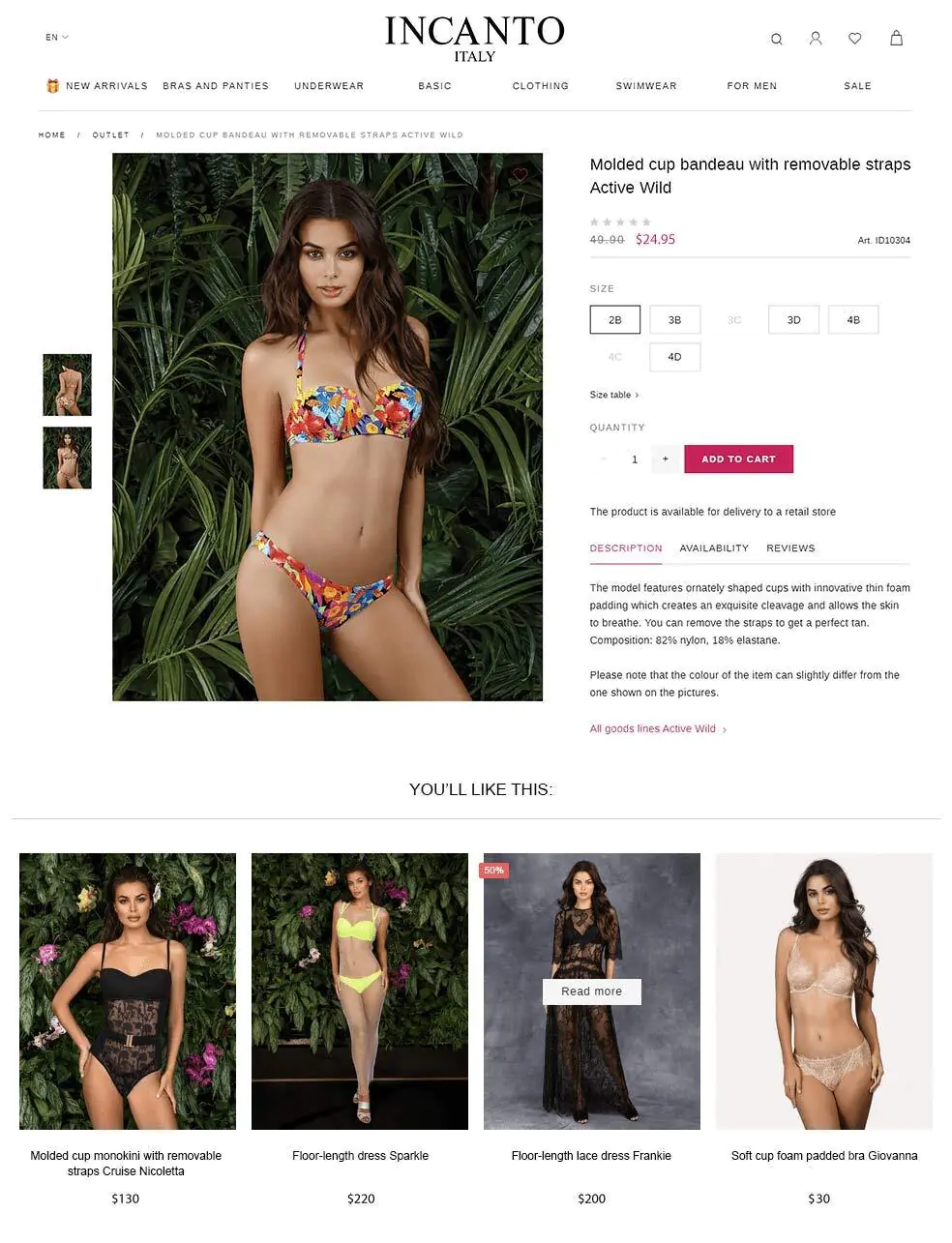
Personalized product recommendations on INCANTO’s website
3. Web Push Notifications
Web push notifications are brief pop-up-like messages from your site that appear over other windows, featuring text, images, and buttons. They’re utilized for engaging with visitors who have left the site and for highlighting special offers — such as discounts or reminders about free shipping.
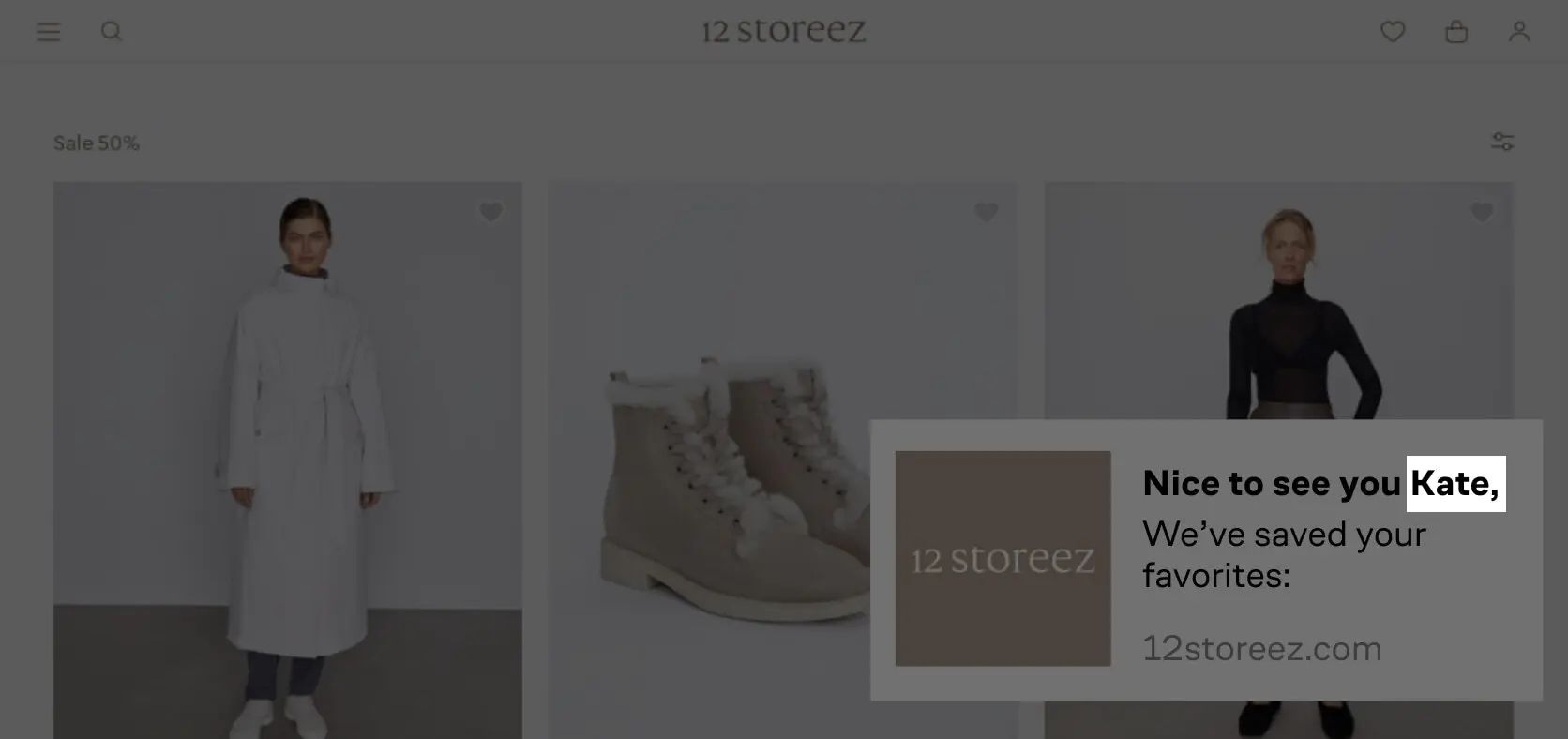
This personalized web push message on fashion brand 12 Storeez’s site was used to direct customers back to items they had saved for later
The effectiveness of a web push lies in its ability to be personal, informative, and immediately appealing, grabbing the user’s attention right away. However, deploying web push notifications requires a nuanced approach compared to other personalization tactics — for a user to receive a web push, they must have opted in to receive these notifications and have granted permission to their browser to display them.
The advantage of web push notifications lies in their non-intrusive nature. Subscription doesn’t require an email or phone number — only the individual’s consent to receive these notifications, the web push doesn’t block the webpage, and it disappears automatically after a few seconds without needing to be dismissed manually. This makes web push a convenient and user-friendly method for maintaining communication with potential customers.
On the flip side, the effectiveness of web push notifications can be limited by users' reluctance to opt-in and automatic blocking by some browsers. Despite these potential hurdles, web push notifications, when used thoughtfully, can be an effective channel for keeping your audience engaged.
4. Web Stories
With 96.5% of internet users accessing the web via mobile devices, and 15% of US adults accessing the web exclusively via smartphones, tailoring content to these consumption habits is crucial. Smartphone users are accustomed to engaging with content in specific formats, such as stories, which are prevalent across all major social networks.
Incorporating stories into your website’s mobile version can be an innovative way to communicate about promotions, new arrivals, and special offers. Mobile stories offer a dynamic and interactive format that’s already ingrained in the daily digital routines of millions — sers can tap to progress to the next piece of content, swipe to skip stories, or hold to pause, giving them control over their viewing experience. By leveraging this format, businesses can create compelling, easily digestible content that captures the essence of their brand and appeals directly to the mobile-first audience.
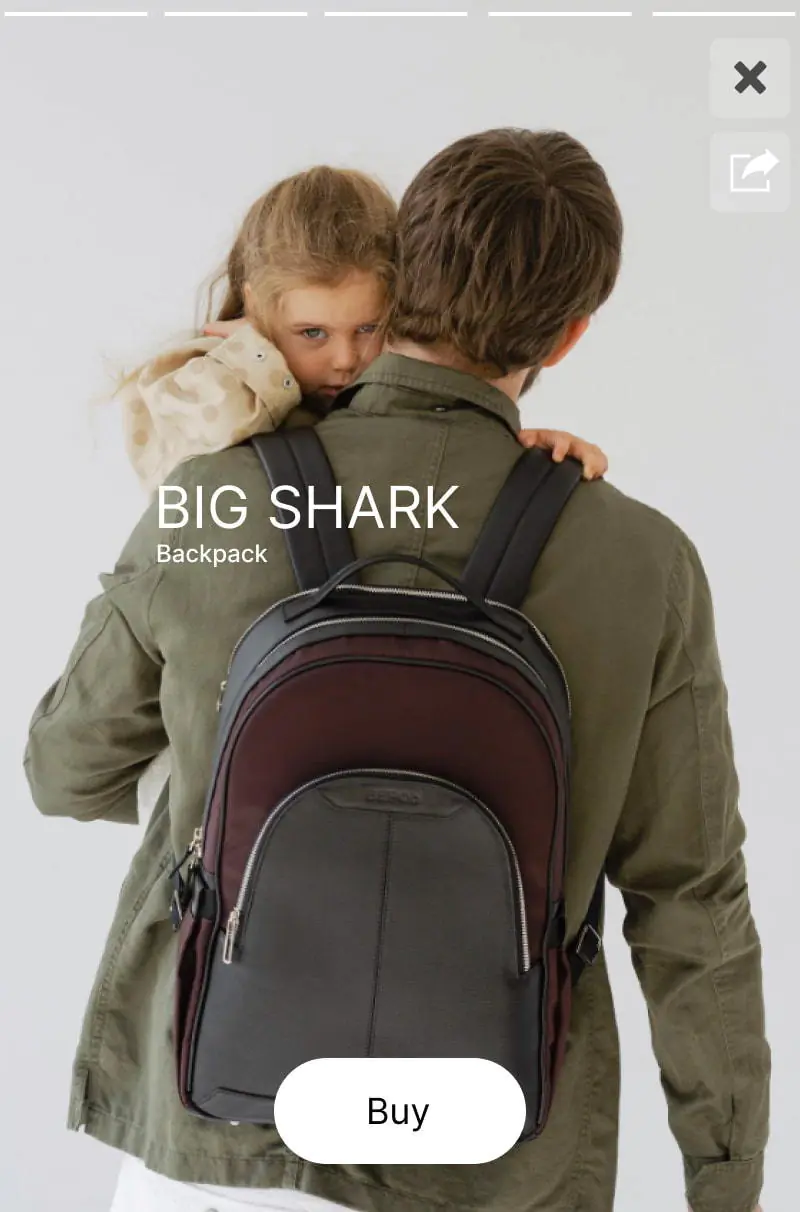
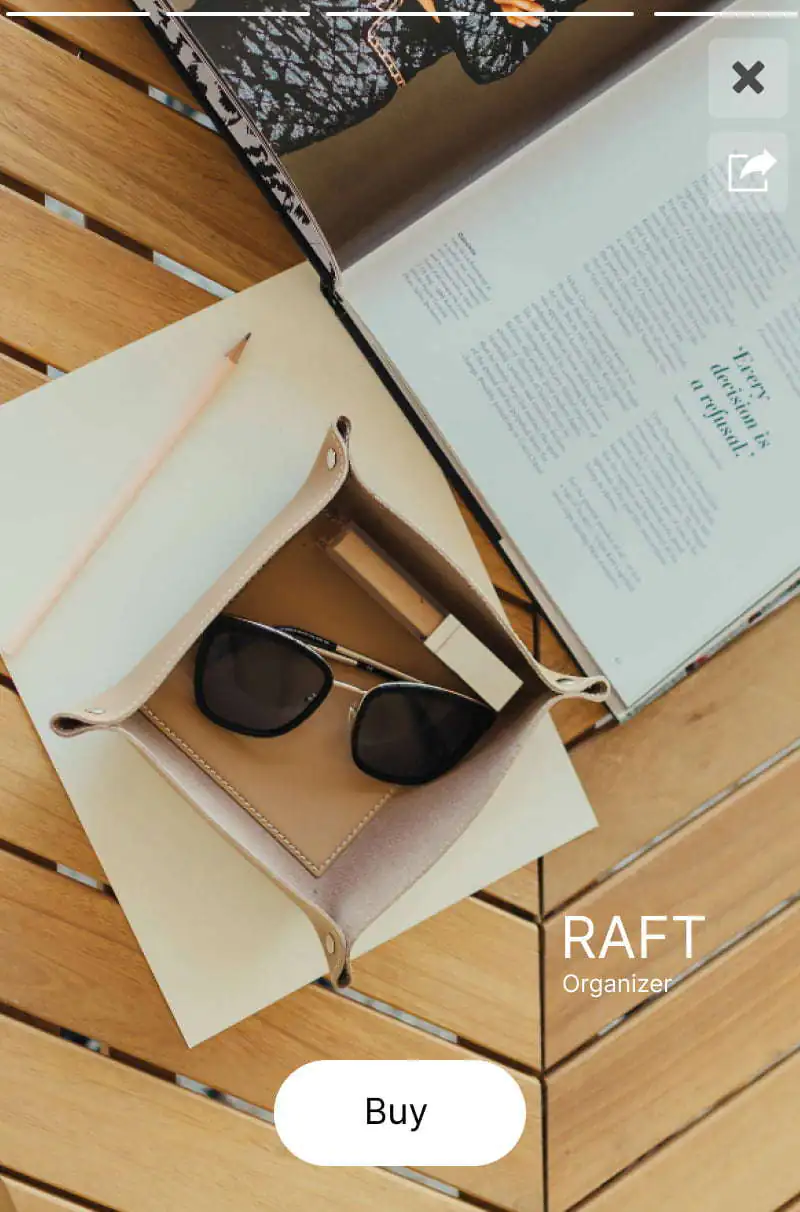
In this example, this brand has used web stories to showcase new items with convenient "Buy" buttons that direct customers to the product pages
5. Dynamic Content
Dynamic content on a website is a powerful tool for personalization that adjusts content in real time based on the user’s past interactions, preferences, and behavior.
For example, Blossom Flower delivery adds personal touches in their product catalog if the site can determine the customer’s name through cookie records. This information is then used to address them directly within the catalog:
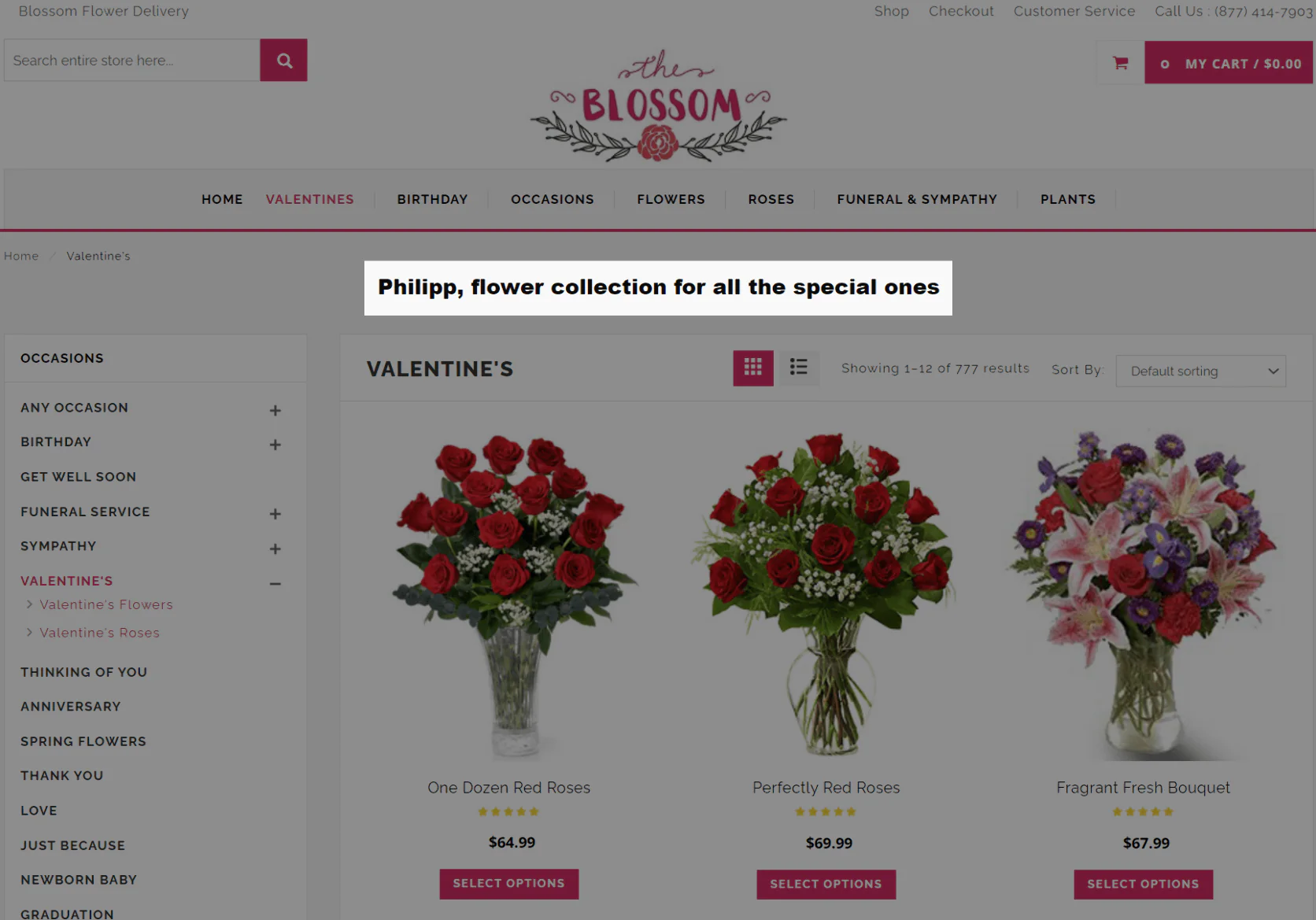
Personalized browsing on Blossom Flower’s website
A personal touch like this can significantly enhance the user experience, creating a warm, personal connection between the brand and the customer, making their online shopping more engaging.
However, it’s important to note here that the success of personalization lies in its subtlety and respect for the customer’s expectations and privacy. Addressing customers by name right upon their return after a long absence might be more jarring than welcoming, highlighting the importance of context. Personalized greetings and interactions are most effective when a user is logged in, indicating a more immediate and engaged relationship with the site.
Checklist: Key Points for Implementing Website Personalization
Effective site personalization can significantly enhance user engagement and conversion rates, but it requires thoughtful implementation. When implementing site personalization, consider these essential factors:
- Conduct A/B Testing: It’s essential to test personalization strategies to evaluate their impact on engagement and sales. A/B testing allows you to compare different approaches and refine your personalization efforts based on concrete outcomes.
- Limit Display Conditions: When employing multiple web personalization tactics, such as pop-ups, embedded content, and stories, carefully manage their triggering conditions. This strategy helps avoid overwhelming your website visitors with too much simultaneous content, ensuring a smoother and more enjoyable personalized browsing experience.
- Match Content with User Preferences: The cornerstone of personalization is delivering content that resonates with the individual user. Collect, analyze, and leverage data on user behavior and preferences to tailor your content and offers to meet their specific interests as much as possible.
Final Thoughts
As we’ve explored, from strategic offers that boost average order values to leveraging the familiar and engaging format of web stories for mobile users, personalization tools offer a spectrum of benefits that improve the user experience. Each tool plays a crucial role in creating a personalized environment that resonates with website visitor on a deeper level.
While web personalisation can come with some obstacles — from data accuracy to technical implementation, with the right marketing tool these become a lot easier to overcome.
Ultimately, through thoughtful implementation, testing, and continuous optimization of personalization tactics, businesses can foster stronger connections with their customers, ultimately leading to increased loyalty, satisfaction, and business growth.


